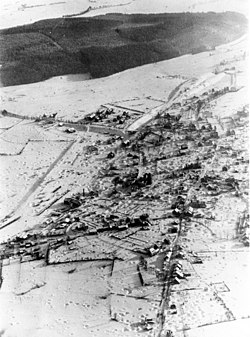| Battle of St. Vith | |||||||
|---|---|---|---|---|---|---|---|
| Part of the Battle of the Bulge, World War II | |||||||
 St. Vith, Belgium | |||||||
| |||||||
| Belligerents | |||||||
|
|
| ||||||
| Commanders and leaders | |||||||
|
|
| ||||||
| Units involved | |||||||
| Strength | |||||||
| 22,000 men[1] |
100,000+ men[2][3] 500 tanks[3] | ||||||
| Casualties and losses | |||||||
|
12,500 KIA, WIA, POW, or MIA[4] 88 tanks, 25 armored cars[1] | Unknown | ||||||


The Battle of St. Vith was an engagement in Belgium fought during the Allied advance from Paris to the Rhine in World War II. It was one of several battles on December 16, 1944 constituting the opening of Germany's Ardennes counteroffensive (more commonly known as the "Battle of the Bulge").
The town of St. Vith, a vital road junction, was close to the boundary between the 5th and Sepp Dietrich’s Sixth Panzer Army, the two strongest units of the attack. St. Vith was also close to the western end of the Losheim Gap, a critical valley through the densely forested ridges of the Ardennes Forest and the axis of the entire German counteroffensive. Opposing this drive were units of the U.S. VIII Corps. These defenders were led by the U.S. 7th Armored Division and included the 424th Infantry (the remaining regiment of the 106th U.S. Infantry Division), elements of the 9th Armored Division's Combat Command B and the 112th Infantry of the U.S. 28th Infantry Division. These units, which operated under the command of Generals Robert W. Hasbrouck (7th Armored) and Alan W. Jones (106th Infantry), successfully resisted the German attacks, thereby significantly slowing the German advance.[4]: 26–32, 310–21, 374
Under orders from Field Marshal Bernard Montgomery, Brigadier General Bruce Cooper Clarke, leader of Combat Command-B 7th Armored Division, gave up St. Vith on 21 December 1944; U.S. troops fell back to positions supported by the 82nd Airborne Division to the west, presenting an imposing obstacle to a successful German advance. By 23 December, as the Germans shattered their flanks, the defenders’ position became untenable and U.S. troops were ordered to retreat west of the Salm River. As the German plan called for the capture of St. Vith by 18:00 on 17 December, the prolonged action in and around it presented a major blow to their timetable.[4]: 468
- ^ a b Samuel W. Mitcham: Panzers in Winter: Hitler's Army And the Battle of the Bulge, Greenwood Publishing Group, 2006, ISBN 0275971155, page 122.
- ^ Trevor Nevitt Dupuy, David L. Bongard, Richard C. Anderson (Jr.), Richard Claire Anderson: Hitler's last gamble: the Battle of the Bulge, December 1944-January 1945, HarperCollins, 1994, ISBN 0060166274, page 155.
- ^ a b Edited by Walt Cross Foreword by Gen. Hasbrouck: From the Beaches to the Baltic: The Story of the 7th Armored Division in World War II, 2006, ISBN 0977192628, page 56.
- ^ a b c MacDonald, Charles B. (1985). A Time for Trumpets, The Untold Story of the Battle of the Bulge. William Morrow and Company, Inc. ISBN 0-688-03923-5.